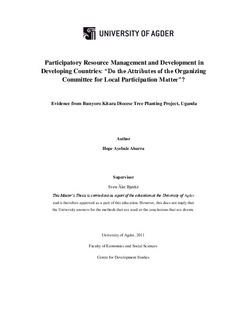| dc.contributor.author | Ahurra, Hope Ayebale | |
| dc.date.accessioned | 2011-10-11T11:52:25Z | |
| dc.date.available | 2011-10-11T11:52:25Z | |
| dc.date.issued | 2011 | |
| dc.identifier.uri | http://hdl.handle.net/11250/135199 | |
| dc.description | Master thesis in development management- University of Agder 2011 | en_US |
| dc.description.abstract | In the past few decades, local community participation has been viewed as one of the major ways through which sustainable resource management can be attained. Communities have been encouraged to take part in resource management projects in order to attain better results. However, there are still some concerns in academic and practitioner circles on how the participatory approach can be implemented in order to gain the most out of it. Hence, pointing to the need for further research on ways of improving participation especially in community resource conservation and development. In this regard, this research set out to discover important areas in the community resource management and development through which the participatory approach can be enhanced based on two cases of the tree planting project in Bunyoro Kitara Diocese in Uganda.
This was achieved by trying to identify the attributes of the organizing committee which might affect the outcome of the participatory approach. Specifically, the study focused on the role of age distribution, gender representation, level of education and level of experience of the organizing committee for participation in sustainable resource management based on a participatory approach. The findings of the research suggest that the attributes of the organizational structure for local participation in question play an important role in the effectiveness of a participatory approach to community resource management.
In particular, having youth, and women represented on the organizing committee highly improves the chances of success of a participatory approach to community resource management. This is also found to be the case when experienced people are represented on these committees. But it is also clear that there are complementary advantages of having men and women, as well as the youth and the old on these committees.
The findings of this study are important for informing and providing insights on how the organization structure for promoting participation in a community project in a developing country can be enhanced by focusing on the people charged with foreseeing the activities of the community project, hence contributing to ways through which participatory approaches can be improved in community resource management. | en_US |
| dc.language.iso | eng | en_US |
| dc.publisher | Universitetet i Agder; University of Agder | en_US |
| dc.subject.classification | UT 503 | |
| dc.title | Participatory resource management and development in developing countries: " do the attributes of the organizing committee for local participation matter"? : evidence from the Bunyoro Kitara Diocese tree planting project, Uganda | en_US |
| dc.type | Master thesis | en_US |
| dc.subject.nsi | VDP::Social science: 200::Social anthropology: 250 | en_US |
| dc.source.pagenumber | 83 s. | en_US |
